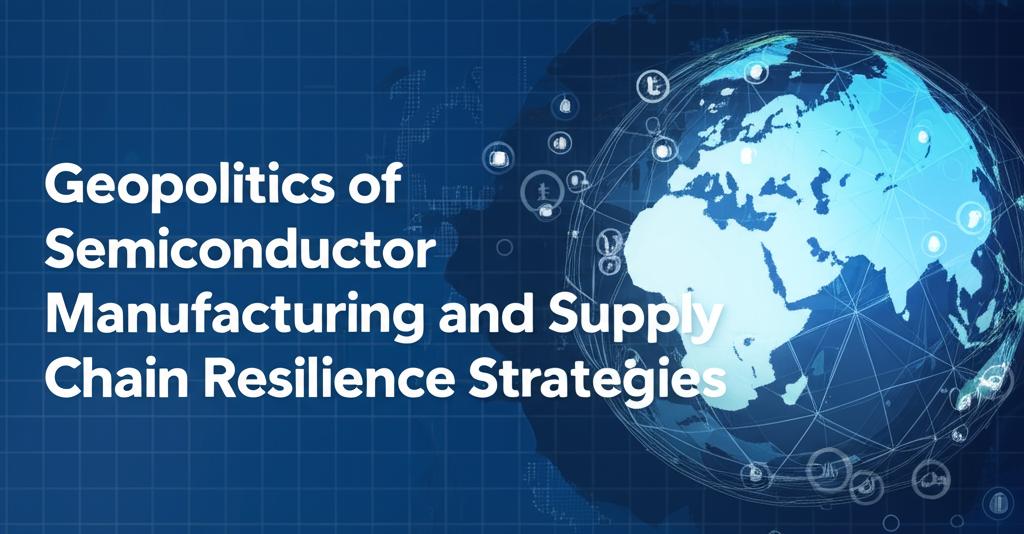Semiconductors are the engines of the modern digital economy, powering everything from consumer electronics and vehicles to advanced artificial intelligence (AI) systems and critical defense infrastructure. Their fundamental importance has placed their manufacturing and supply chains at the heart of intense geopolitical competition and strategic planning globally. The fragility of these supply chains, starkly exposed by the COVID-19 pandemic and subsequent disruptions, has accelerated efforts by nations to bolster their semiconductor capabilities and reduce dependencies.
The Geopolitical Arena: Competition and National SecurityThe semiconductor landscape in 2025 is heavily influenced by geopolitical tensions, most notably the ongoing technological rivalry between the United States and China. The US has implemented export controls aimed at limiting China's access to advanced semiconductor technology and manufacturing equipment, citing national security concerns. Initiatives like the US CHIPS and Science Act, allocating significant funding (over $52 billion) aim to revitalize domestic manufacturing, research, and development, seeking to reverse decades of declining US production share and secure critical supply lines.
China, in response and driven by long-term goals articulated in plans like "Made in China 2025," is heavily investing in achieving semiconductor self-sufficiency. While facing headwinds from US restrictions, particularly in accessing cutting-edge fabrication tools, China is channeling vast state funding into its domestic industry, focusing on R&D, mature chip production, and building its own ecosystem to counter external pressures.
Taiwan remains a crucial focal point, housing TSMC, which dominates the global production of the most advanced chips (under 10nm nodes). This concentration makes Taiwan strategically vital but also vulnerable, given the geopolitical tensions across the Taiwan Strait. Taiwan itself is actively pursuing strategies, like its "Taiwan Semiconductor Strategic Policy 2025", to enhance its technological leadership, diversify manufacturing locations within the island, strengthen its talent pipeline, and engage in "tech diplomacy" with partners like Japan, the EU, and India.
The European Union, through its European Chips Act, is also striving for greater "technological sovereignty," aiming to double its global market share in semiconductor production to 20% by 2030. Key European players, like ASML in lithography equipment, provide strategic leverage, but the EU faces challenges in translating subsidies into competitive innovation and manufacturing scale effectively.
Emerging players, particularly in South Asia like India, are positioning themselves as alternative hubs. India's Semiconductor Mission, backed by substantial government incentives ($10 billion), is actively courting global firms to establish design and fabrication facilities, aiming to diversify global supply chains.
Supply Chain Vulnerabilities and the Quest for ResilienceThe intricate global semiconductor supply chain, involving hundreds of production stages across numerous countries, has proven susceptible to disruption. Geographic concentration is a major vulnerability, with East Asia accounting for roughly 75% of global manufacturing capacity. This exposes the supply chain to risks from natural disasters, geopolitical conflicts, and pandemics, as seen with the chip shortages that significantly impacted the automotive and electronics industries.
Beyond fabrication (fabs), potential bottlenecks are emerging in "back-end" processes like Assembly, Test, and Packaging (ATP). While advanced chip manufacturing is concentrated, ATP is also geographically specific, with Southeast Asian nations like Malaysia playing a significant historical role, and potentially expanding roles for countries like Mexico through nearshoring initiatives.
Strategies for Building ResilienceGovernments and corporations worldwide are actively pursuing strategies to enhance supply chain resilience:
- Diversification and Regionalization: The primary trend is moving away from hyper-globalized, concentrated supply chains towards more geographically diverse and regionalized models. This involves:
Localization: Investing heavily in domestic manufacturing capacity through subsidies and incentives (e.g., CHIPS Acts in US/EU, India's mission).
Multi-Sourcing: Companies are actively seeking multiple suppliers across different regions for critical components and materials to avoid single-source dependency.
Nearshoring/Friend-shoring: Relocating parts of the supply chain to closer or geopolitically aligned countries.
- Technological Innovation: Advanced technologies are being leveraged to improve efficiency and adaptability:
AI and IoT: Smart factories use AI for predictive maintenance, optimized production scheduling, and improved demand forecasting, helping to anticipate and mitigate disruptions.
* Advanced Materials and Packaging: Innovations like chiplets, 3D stacking, and new materials (like Gallium Nitride - GaN, Silicon Carbide - SiC) enhance performance and can influence supply chain needs.
- Ecosystem Development: Building resilience requires more than just fabs. Efforts focus on creating complete domestic or regional ecosystems encompassing R&D, chip design (EDA tools), advanced packaging, materials supply, and a skilled workforce.
- Talent Development: Addressing the significant shortage of skilled engineers and technicians is critical. Initiatives include university partnerships, specialized training programs, and visa programs to attract global talent.
- Strategic Collaboration: Despite competition, international partnerships remain vital for R&D, setting technology standards, and ensuring access to specialized equipment and materials. Companies are forging global partnerships to support investment plans and secure supply.
The demand for semiconductors is projected to continue growing strongly, driven by AI, 5G deployment, electric vehicles, IoT, and data center expansion, potentially making it a trillion-dollar industry by 2030. However, the landscape will continue to be shaped by geopolitical maneuvering, national industrial policies, and the push for supply chain security. While complete self-reliance is likely unattainable due to the complexity and global nature of the value chain, the trend towards greater diversification, localization, and resilience-focused investments is set to continue, reshaping the global map of semiconductor production and influence in the years to come. Navigating this complex environment requires strategic foresight, significant investment, and robust collaboration across industries and governments.

